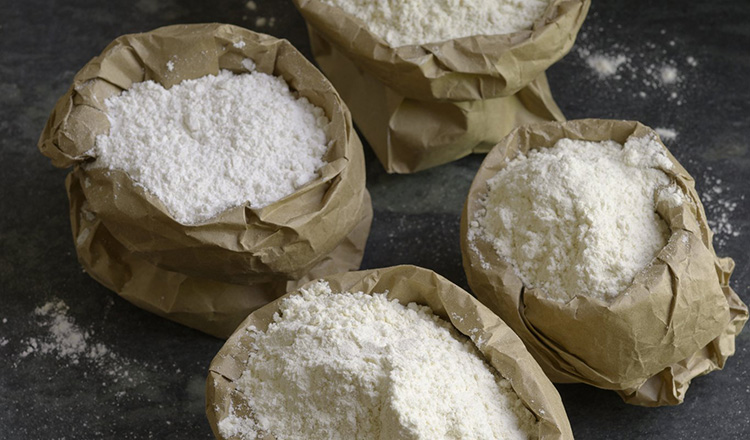
We’ve all been baking a lot while we’re stuck at home, and the demand for all-purpose flour is leading to empty shelves and empty pantries.
Luckily, all-purpose flour is only one option among many, and specialty flours are more likely to be available at your local market. Let’s explore the varieties of flour that you might come across so you can choose the best replacement for you.
- All-purpose flour is a blend of “soft” (low-protein) and “hard” (high-protein) wheats and is called for in a majority of baked goods. It is between 8 and 12% protein, depending on the brand. All-purpose flour is often bleached, but you can purchase unbleached flour. You won’t notice a dramatic difference using one over the other, and it’s a matter of preference.
- Whole wheat flour is a hard wheat flour milled from the entire wheat kernel, including the bran and germ; because the germ is high in lipids (fats), whole wheat flour can quickly become rancid. Its protein content ranges from 14 to 16%. Whole wheat flour is typically blended with white flour (like all-purpose) in baking recipes.
- Bread flour has more protein and is considered “stronger,” making it appropriate to use in most yeast bread recipes. It is between 11 and 13% protein, depending on the brand. It can be found in white and whole wheat varieties.
- Pastry flour has a protein content ranging from 8 to 10%. It is used for pie crust dough, muffins, and some biscuits, as well as pastries.
- Cake flour has less protein and is “softer” than either bread or all-purpose flour. It is used in most cake and many cookie and muffin recipes for a less chewy, more tender result. It is between 6 and 9% protein, depending on the brand.
- Self-rising flour is all-purpose flour that is already blended with baking powder and salt. You shouldn’t use this flour unless it is specifically called for in a recipe.
Though each has an ideal use, all-purpose flour, bread flour, pastry flour, and cake flour can be interchangeable in a pinch. The results may be slightly different, but the swap won't ruin a recipe.
If you use whole wheat flour in a recipe that does not specifically call for it, you may need to add additional liquids, since whole wheat flour absorbs more moisture than white flours. You can substitute whole wheat flour for about 1/4 of the total white flour in a recipe without noticing a huge difference, but any more than that will yield a much denser, probably drier finished baked good.
As a guideline, we recommended using organic, unbleached, unbromated flour.
Why organic? Lots of studies have tried to prove or disprove that organic foods are more nutritious than conventionally grown ones. It’s hard to say what is true. It is easy, however, to make the argument that organic foods taste better, and that there may be unknown beneficial nutrients in a plant that has had to fend off pests and diseases without the assistance of chemicals or pesticides.
Better tasting wheat will, in turn, make a better loaf of bread. Organic flour does cost more, and if the higher cost does not fit into your budget, conventional flour will still make a good loaf of bread.
But you should avoid using bleached flour because it is less healthful. Why is flour bleached in the first place? Flour fresh from the mill is considered “green.” In other words, it needs time to get exposed to air, which naturally whitens it to a degree, and also further develops its gluten-forming ability. But this takes time, and flour that is sitting around aging is taking up space. Bleaching speeds up the aging process. Bleached flour is processed with benzoyl peroxide or chlorine gas to simulate aging so that the mill producing it can turn out more flour faster.
As a negative side effect, the flour’s naturally occurring nutrients are lost, so vitamins and minerals must be added back in. In addition, the process bleaches away the flour’s natural carotenoid coloring, which also happens to provide the flavor. Who knows what else is lost in the process?
Bleached flour is a bland, sometimes chemical-tasting, snowy white flour. Unbleached flour, on the other hand, is aged naturally with air, and retains its good creamy color, flavor and nutrients. Unbleached organic flour is even better.
There are other chemical processes that have been banned in the United Kingdom and Canada that are still practiced in the United States, such as bromating flour. Bromides help to make flour stronger, but some studies suggest that bromides cause cancer. The Food and Drug Administration has asked bakers to voluntarily stop using them, but the agency has not banned the substance.

Looking for SAF Red Star Instant Yeast. Any source you know of to buy from now?
I’m afraid not. It seems the whole world is baking bread right now. Though I usually use Red Star myself, I’ve been buying whatever I can get my hands on, and so far, so good.
Would it be possible to go over some of the other flour like oat flour, almond flour etc. thanks
For sure! Keep an eye out, we’ll post soon.